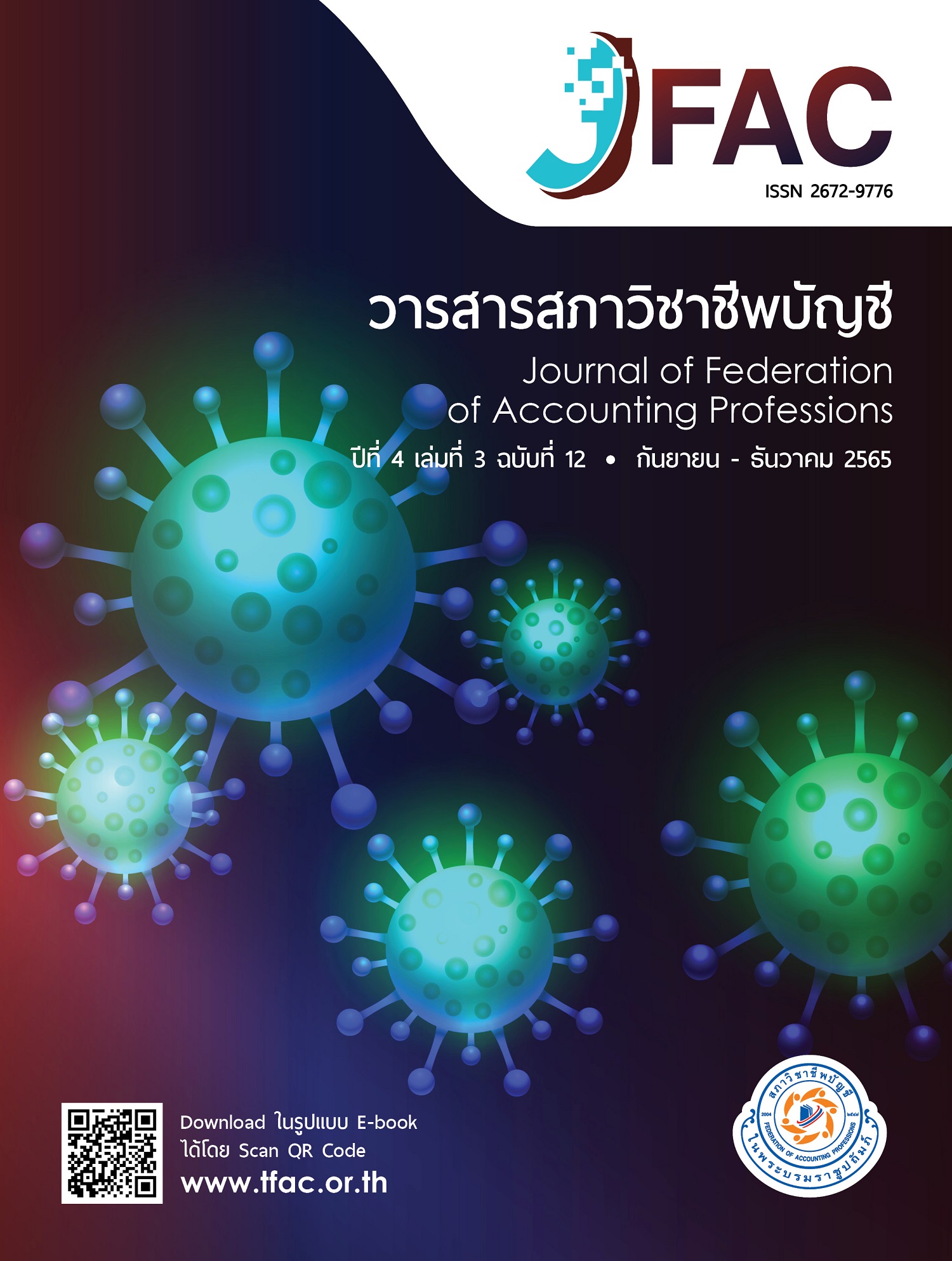การนำมาตรฐานการรายงานทางการเงินมาใช้เป็นครั้งแรก ต่อการกำหนดค่าธรรมเนียมการสอบบัญชี: หลักฐานเชิงประจักษ์จากตลาดหลักทรัพย์แห่งประเทศไทย
Main Article Content
บทคัดย่อ
งานวิจัยนี้มีวัตถุประสงค์เพื่อศึกษาผลกระทบรวมและแยกในแต่ละฉบับจากการนำมาตรฐานการรายงานทางการเงินมาใช้เป็นครั้งแรกต่อการกำหนดค่าธรรมเนียมการสอบบัญชี โดยมาตรฐานการรายงานทางการเงินที่นำมาใช้ในการศึกษาครั้งนี้ ประกอบด้วย มาตรฐานการรายงานทางการเงิน ฉบับที่ 9 เครื่องมือทางการเงิน และฉบับที่ 16 สัญญาเช่า ซึ่งสภาวิชาชีพบัญชีฯ กำหนดให้ถือปฏิบัติสำหรับรอบระยะเวลาบัญชีที่เริ่มในหรือหลังวันที่ 1 มกราคม พ.ศ. 2563 เป็นต้นไป กลุ่มตัวอย่างที่ใช้ในงานวิจัย คือ บริษัทจดทะเบียนในตลาดหลักทรัพย์แห่งประเทศไทย จำนวนรวม 429 บริษัท โดยเก็บรวบรวมข้อมูลจากงบการเงินและรายงานประจำปีของบริษัทในปี พ.ศ. 2563 สำหรับสถิติอ้างอิงหลักที่ใช้ในการวิจัย คือ การวิเคราะห์ถดถอยพหุคูณ ผลการวิจัยพบว่า การนำมาตรฐานการรายงานทางการเงินฉบับที่ 9 และฉบับที่ 16 มาถือปฏิบัติเป็นครั้งแรกไม่มีผลกระทบอย่างมีนัยสำคัญทางสถิติต่อการกำหนดค่าธรรมเนียมการสอบบัญชี นอกจากนี้ เมื่อศึกษาผลกระทบแยกแต่ละฉบับพบว่า การนำมาตรฐานการรายงานทางการเงินฉบับที่ 9 มาถือปฏิบัติเป็นครั้งแรกไม่มีผลกระทบอย่างมีนัยสำคัญทางสถิติต่อการกำหนดค่าธรรมเนียมการสอบบัญชี ในขณะที่การนำมาตรฐานการรายงานทางการเงินฉบับที่ 16 มาถือปฏิบัติเป็นครั้งแรกมีผลกระทบเชิงบวกอย่างมีนัยสำคัญทางสถิติต่อการกำหนดค่าธรรมเนียมการสอบบัญชี สำหรับกลุ่มตัวอย่างที่มีการปรับปรุงรายการซึ่งทำให้สินทรัพย์สุทธิต้นงวดลดลง แต่ไม่มีผลกระทบอย่างมีสาระสำคัญทางสถิติสำหรับกลุ่มตัวอย่างที่มี
การปรับปรุงรายการซึ่งทำให้สินทรัพย์สุทธิต้นงวดเพิ่มขึ้น งานวิจัยนี้เป็นงานวิจัยแรกในประเทศไทยที่ทำการศึกษาผลกระทบจากการนำมาตรฐานการรายงานทางการเงินเฉพาะเรื่องมาใช้เป็นครั้งแรกต่อการกำหนดค่าธรรมเนียม
การสอบบัญชี
Article Details
เนื้อหาและข้อมูลในบทความที่ลงตีพิมพ์ในวารสารสภาวิชาชีพบัญชี ถือเป็นข้อคิดเห็นและความรับผิดชอบของผู้เขียนบทความโดยตรงซึ่งกองบรรณาธิการวารสารไม่จำเป็นต้องเห็นด้วยหรือร่วมรับผิดชอบใด ๆ
บทความ ข้อมูล เนื้อหา รูปภาพ ฯลฯ ที่ได้รับการตีพิมพ์ในวารสารสภาวิชาชีพบัญชี ถือเป็นลิขสิทธิ์ของวารสารสภาวิชาชีพบัญชี หากบุคคลหรือหน่วยงานใดต้องการนำข้อมูลทั้งหมดหรือบางส่วนไปเผยแพร่ต่อหรือเพื่อกระทำการใดๆ จะต้องได้รับอนุญาตเป็นลายลักษณ์อักษรจากวารสารสภาวิชาชีพบัญชี ก่อนเท่านั้น
เอกสารอ้างอิง
References
Alexeyeva, I., & Svanström, T. (2015). The impact of the global financial crisis on audit and non-audit fees: Evidence from Sweden. Managerial Auditing Journal, 30(4/5), 302-323.
Arunruangsirilert, T., Thammanoo, J., & Sangiumvibool, P. (2022). Effect of Complying IFRS 9 on Firm Value of Commercial Banks on the London Stock Exchange. Journal of Federation of Accounting Professions, 4 (10): 5-19.
Basioudis, I. G., & Francis, J. R. (2007). Big 4 audit fee premiums for national and office‐level industry leadership in the United Kingdom. Auditing: A Journal of Practice & Theory, 26(2), 143-166.
Bedard, J. C., & Johnstone, K. M. (2004). Earnings manipulation risk, corporate governance risk, and auditors' planning and pricing decisions. The Accounting Review, 79(2), 277-304.
Carcello, J. V., Hermanson, D. R., Neal, T. L., & Riley Jr, R. A. (2002). Board characteristics and audit fees. Contemporary accounting research, 19(3), 365-384.
Charles, S. L., Glover, S. M., & Sharp, N. Y. (2010). The association between financial reporting risk and audit fees before and after the historic events surrounding SOX. Auditing: A Journal of Practice & Theory, 29(1), 15-39.
Chen, H., Hua, S., Liu, Z., & Zhang, M. (2019). Audit fees, perceived audit risk, and the financial crisis of 2008. Asian Review of Accounting, 27(1), 97-111.
Cohn, M. (2021). Audit fee spikes as complexity rises. Retrieved from http://www.accountingtoday.
com/news/ audit-fee-spikes-as-accounting-complexity-rises
De George, E. T., Ferguson, C. B., & Spear, N. A. (2013). How much does IFRS cost? IFRS adoption and audit fees. The accounting review, 88(2), 429-462.
Fang, X., Guo, Y., Mei, B., & Ye, J. (2022). Implementation costs of IFRS 9 for non‐financial firms: evidence from China. Accounting & Finance, 62(2), 2781-2805.
Gonthier‐Besacier, N., & Schatt, A. (2007). Determinants of audit fees for French quoted firms. Managerial Auditing Journal, 22(2), 139-160.
Hail, L., Leuz, C., & Wysocki, P. D. (2009). Global accounting convergence and the potential adoption of IFRS by the United States: An analysis of economic and policy factors. Retrieved from https://papers.ssrn.com/sol3/papers.cfm?abstract_id=1357331
Hair, J. F., Anderson, R. E., Babin, B. J., & Black, W. C. (2010). Multivariate data analysis: A global perspective (Vol. 7). Upper Saddle River, NJ: Pearson.
Hardies, K., Breesch, D., & Branson, J. (2015). The female audit fee premium. Auditing: A Journal of Practice & Theory, 34(4), 171-195.
Jermakowicz, E. K., & Gornik-Tomaszewski, S. (2006). Implementing IFRS from the perspective of EU publicly traded companies. Journal of international accounting, auditing and taxation, 15(2), 170-196.
Johnstone, K. M., & Bedard, J. C. (2004). Audit firm portfolio management decisions. Journal of Accounting Research, 42(4), 659-690.
Joshi, P. L., & Al‐Bastaki, H. (2000). Determinants of audit fees: evidence from the companies listed in Bahrain. International journal of auditing, 4(2), 129-138.
Kim, J. B., Liu, X., & Zheng, L. (2012). The impact of mandatory IFRS adoption on audit fees: Theory and evidence. The Accounting Review, 87(6), 2061-2094.
Lifschutz, S., Jacobi, A., & Feldshtein, S. (2010). Corporate governance characteristics and external audit fees: A Study of large public companies in Israel. International Journal of business and management, 5(3), 109.
Loukil, L. (2016). The impact of IFRS on the amount of audit fees: the case of the large French listed companies. Quarterly Journal of Finance and Accounting, 41-68.
Mitra, S., Hossain, M., & Deis, D. R. (2007). The empirical relationship between ownership characteristics and audit fees. Review of Quantitative Finance and Accounting, 28(3), 257-285.
Murphy, M.L. (2021). FERF study: Average audit fees inch higher in 2019. Retrieved from http://
www.complianceweek.com/accounting-and-auditing/ferf-study-average-audit-fees-incj-higher-in-2019/30096.article
Simunic, D. A. (1980). The pricing of audit services: Theory and evidence. Journal of accounting research, 161-190.
Wongariyaporn, S. (2017). Knowing the impact of TFRS9. Retrieved from https://www.efinancethai.
com/MoneyStrategist/MoneyStrategistMain.aspx?id=1764
Thailand Federation of Accounting Professions (TFAC). (2020a). TAS 8: Accounting Policies, Changes in Accounting Estimates and Errors. Retrieved from http://www.tfac.or.th/Article/ Detail/119612
Thailand Federation of Accounting Professions (TFAC). (2020b). TFRS 9: Financial Instruments. Retrieved from http://www.tfac.or.th/Article/ Detail/119612
Thailand Federation of Accounting Professions (TFAC). (2020c). TFRS 16: Leases. Retrieved from http://www.tfac.or.th/Article/ Detail/119612
Thailand Federation of Accounting Professions (TFAC). (2020d). TSA 210: Agreeing the Terms of Audit Engagements. Retrieved from https://acpro-std.tfac.or.th/standard/49/Thai-Standards-on-Auditing-Year-2020
Tubsrilak, C. (2012). Regression analysis for qualitative variables. Journal of Educational Measurement, 17(1). Retrieved from https://so02.tci-thaijo.org/index.php/jemmsu/issue/
view/11764
Yaacob, N. M., & Che-Ahmad, A. (2012). Audit fees after IFRS adoption: Evidence from Malaysia. Eurasian Business Review, 2(1), 31-46.
Yao, D. F. T., Percy, M., & Hu, F. (2015). Fair value accounting for non-current assets and audit fees: Evidence from Australian companies. Journal of Contemporary Accounting & Economics,
(1), 31-45.


